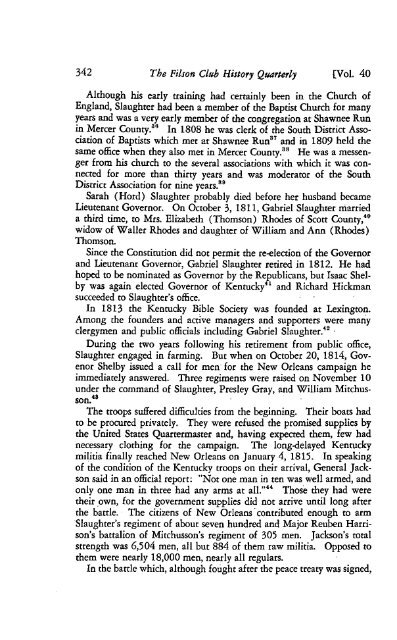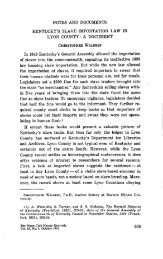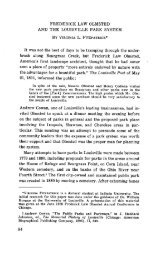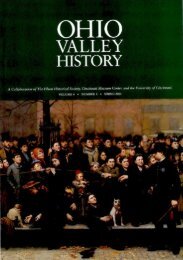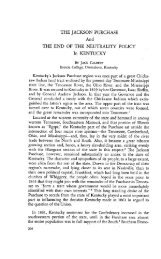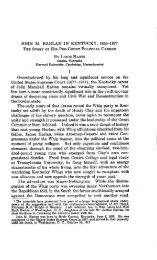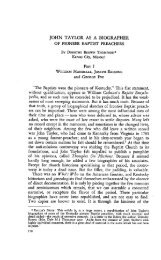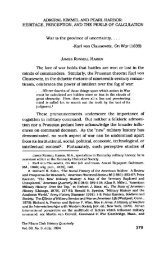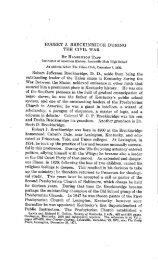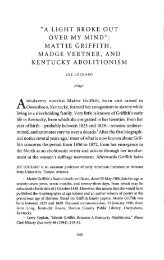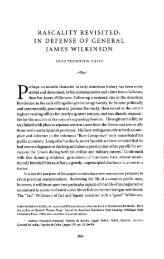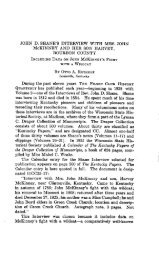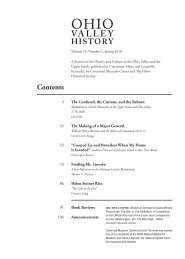GABRIEL SLAUGHTER, 1767-1830 G•OVERNOR OF KENTUCKY ...
GABRIEL SLAUGHTER, 1767-1830 G•OVERNOR OF KENTUCKY ...
GABRIEL SLAUGHTER, 1767-1830 G•OVERNOR OF KENTUCKY ...
You also want an ePaper? Increase the reach of your titles
YUMPU automatically turns print PDFs into web optimized ePapers that Google loves.
342 The Filson Club History Quarterly [Vol. 40<br />
Although his early training had certainly been in the Church of<br />
England, Slaughter had been a member of the Baptist Church for many<br />
years and was a very early member of the congregation at Shawnee Run<br />
in Mercer County. 3 In 1808 he was clerk of the South District Association<br />
of Baptists which met at Shawnee Runa and in 1809 held the<br />
same office when they also met in Mercer County.3s He was a messenger<br />
from his church to the several associations with which it was connected<br />
for more than thirty years and was moderator of the South<br />
District Association for nine years.89<br />
Sarah (Hord) Slaughter probably died before her husband became<br />
Lieutenant Governor. On October 3, 1811, Gabriel Slaughter married<br />
a third time, to Mrs. Elizabeth (Thomson) Rhodes of Scott County,4°<br />
widow of Waller Rhodes and daughter of William and Ann (Rhodes)<br />
Thomson.<br />
Since the Constitution did not permit the re-election of the Governor<br />
and Lieutenant Governor, Gabriel Slaughter retired in 1812. He had<br />
hoped to be nominated as Governor by the Republicans, but Isaac Shelby<br />
was again elected Governor of Kentucky41 and Richard Hickman<br />
succeeded to Slaughter's office.<br />
In 1813 the Kentucky Bible Society was founded at Lexington.<br />
Among the founders and active managers and supporters were many<br />
clergymen and public officials including Gabriel Slaughter. 2<br />
During the two years following his retirement from public office,<br />
Slaughter engaged in farming. But when on October 20, 1814, Govenor<br />
Shelby issued a call for men for the New Orleans campaign he<br />
immediately answered. Three regiments were raised on November 10<br />
under the command of Slaughter, Presley Gray, and William Mitchusson.48<br />
The troops suffered difficulties from the beginning. Their boats had<br />
to be procured privately. They were refused the promised supplies by<br />
the United States Quartermaster and, having expected them, few had<br />
necessary clothing for the campaign. The long-delayed Kentucky<br />
militia finally reached New Orleans on January 4, 1815. In speaking<br />
of the condition of the Kentucky troops on their arrival, General Jackson<br />
said in an official report: "Not one man in ten was well armed, and<br />
only one man in three had any arms at all. ''44 Those they had were<br />
their own, for the government supplies did not arrive until long after<br />
the battle. The citizens of New Orleans contributed enough to arm<br />
Slaughter's regiment of about seven hundred and Major Reuben Harrison's<br />
battalion of Mitchusson's regiment of 305 men. Jackson's total<br />
strength was 6,504 men, all but 884 of them raw militia. Opposed to<br />
them were nearly 18,000 men, nearly all regulars.<br />
In the battle which, although fought after the peace treaty was signed,


